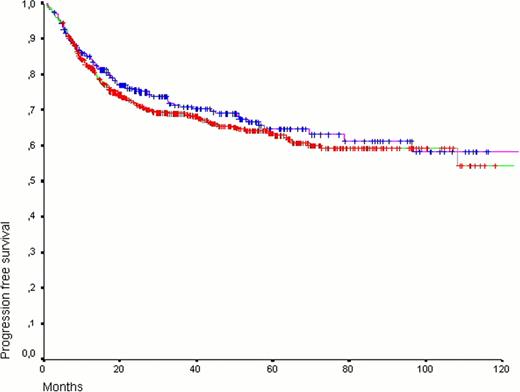Abstract
Abstract 1615
Diffuse large B cell lymphoma (DLBCL) is one of the most common types of non-Hodgkin's lymphoma. R-CHOP21 (C21) is considered the standard therapy but a large number of studies have tested R-CHOP14 (C14).
The aim of our study was to evaluate retrospectively a cohort of patients (pts) treated with C21 or C14 and to compare the efficacy of the therapy.
All pts with diagnosis of DLBCL or follicular grade IIIb lymphoma, treated with curative intent in 9 Italian Hematological Centers, were accrued. All patients treated with C14 used G-CSF as primary prophilaxis, and only elderly (over 70 years) patients treated with C21 used G-CSF as primary prophilaxis.
From january 2002 to june 2011, 950 pts were accrued, 643 pts were treated with C21 and 307 were treated with C14. The median age was 63 (range 19–89). The two cohorts of pts were balanced for all clinical characteristics a part for age (<60 or >60 years) with more aged pts in C21 arm (p 0.001), bone marrow positivity and more than 3 lymph node stations involved that were higher in C14 arm (p: 0.05 and p: 0.001). After induction therapy 751 pts (79%) obtained a complete remission: 501/643 (78%) after C21 and 250/307 (81%) after C14. The remaining pts obtained partial response in 110 and 48 or no response in 32 and 9 respectively for C21 and C14. After a median period of observation of 38 months 104 pts relapsed (14%), 68 (65%) in the C21 arm and 36 (35%) in the C14 arm. After a median observation period of 3 years, considering the two therapies, C21 vs C14, no differences were reported in OS (Figure 1), PFS (Figure 2) and DFS: 80% vs 84%, 69% vs 71% and 54% vs 56% respectively. In univariate analysis OS was lower in older pts (azard ratio (ar): 2.57), IPI 2 (ar: 2.09), IPI 3 (ar: 4.36), IPI 4–5 (ar: 6.36), bulky disease (ar: 1.70), symptomatic disease (ar: 2.23). In multivariate analysis factors which mantained significantly worst prognosis were older age (ar: 1.35), IPI 2 (ar: 1.95), IPI 3 (ar: 3.76), IPI 4–5 (ar: 5.01) and bulky disease (ar: 1.43). As expected hematological grade III/IV toxicity was more frequent in pts treated with C14. No differences in extra-hematological toxicity were observed. Secondary malignancies were reported: 7 in C21 and 3 in C14. After 3 years of median observation 188 pts are dead: 137 (73%) in C21 and 51 (27%) in C14 (not statistically significant, p:0.08). The large majority of pts are dead for disease progression or relapse.
In conclusion our results confirm that C14 do not improve the results of the standard C21 in the whole lymphoma population. Dose dense therapy did not affect OS or PFS also analysing sub group of pts. As expected a higher frequency of neutropenia was observed in C21 arm but did not translate in increasing infection rate. Further prospective randomized studies are needed to verify this preliminary observations.
No relevant conflicts of interest to declare.
Author notes
Asterisk with author names denotes non-ASH members.



